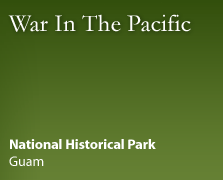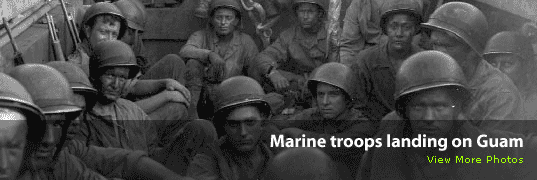|
Saipan and the other islands of the Northern Marianas were German-controlled until seized by Japan in World War I. Following the war, Japanese rule was recognized under the League of Nations mandate. Located only 1,250 miles from Tokyo, Saipan became a vital Japanese administrative, supply, and communications center.
The assault on the Marianas was the first breaching of the inner defensive line of Japan’s empire. The orders to proceed with Operation FORAGER, as the invasion was code-named, were issued by Admiral Chester W. Nimitz, Commander- in- Chief of the U.S. Pacific Fleet and Pacific Ocean Areas. The landings were carried out by the 5th Amphibious Corps, commanded by Lt. General Holland Smith.
On June 25th, following six days of bombardment by ships and planes, U.S. Marines of the 2 nd and 4th Divisions landed on the southwestern coast of the island at Chalan Kanoa. The Army’s 27th Infantry Division followed them ashore.
Despite having undergone days of bombing, Japanese forces fiercely opposed the landings. The 31st Army, commanded by Lt. General Saito Yoshitsugu, inflicted over 4,000 causalities on the Americans in the first two days of fighting.
Overcoming this opposition, the 2 nd Marines took Garapan, and the 4th Marines captured Aslito Airfield on June 18th. Having failed to contain the invaders, General Saito was forced to withdraw from the defensive lines in the north and in the island’s central highlands.
The capture of Mt.Tapotchau on June 27th by U.S. Marine units was accomplished only with difficult, bloody fighting. The 27th Infantry Division attacked the most heavily defended Japanese positions, located east of the peak in steep, heavily forested terrain that the Americans came to call Purple Heart Ridge and the Valley of Death. The defenders were overcome with the aide of accurate fire from naval forces, and the American advance continued.
The last organized resistance on Saipan came on the night of July 6-7, with a mass attack by Japanese forces assembled in the region near Makunsha Village. Some participants were armed only with hastily made spears. They charged along the coastal lowlands towards Tanapag Village, hoping to reach and destroy American supply depots. This tactic is often called a banzai attack, a term, used by the allies derived from the battle cry Tenno heika banzai or Long live the Emperor, but more commonly known among the Japanese as a gyokusai attack, which loosely translates as breaking of the jewels. This was the largest such attack of the War and estimates of the resulting Japanese dead range from three to four thousand.
Following this slaughter, American forces advanced up the island to Marpi Point. Most of the remaining Japanese military leaders and troops and some civilians chose suicide over surrender. Among the military, this choice was based on the warrior’s code (Bushido) which forbade surrender. The civilian deaths were partially the result of propaganda which led civilians to expect torture and death from the Americans. In addition, there were an unknown number of incidents in which Japanese military personnel killed civilians or forced them to kill themselves.
The island was declared secure on July 9, 1944. Several small groups of Japanese soldiers who had avoided the suicidal final charge took to the forests and mountains of the island to continue the fight. The largest, best organized of these groups was led by Captain Sakae Oba. Refusing to believe early reports of the surrender of Japan, he and about fifty battle-weary followers fought on, finally emerging from the jungle to surrender on December 1, 1945.
Over 28,000 Japanese died in the battle for Saipan, while almost 3,500 Americans perished. With the island’s capture, the Americans penetrated the inner defenses of the Japanese Empire and began the final phases of the War. American intelligence analysts gained literally tons of secret and sensitive documents that revealed much about Japanese military planning and strategy, and sided in the decoding and interpreting of Japanese communications.
Most importantly, Saipan and other islands of the Marianas became the prime launching platform for airborne attacks against the Japanese home islands. In November, 1944, American Army Air Corps units flying the B-29 Superfortress, the world’s first strategic bomber, began the destructive bombing that would culminate in the atomic bombings of Hiroshima and Nagasaki, ending the Pacific War. Emperor Hirohito announced the defeat of Japan on August 15 and the formal surrender was signed aboard the USS Missouri in Tokyo Bay.
Text courtesy of American Memorial Park brochure
|





